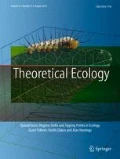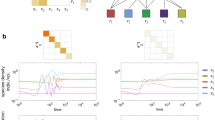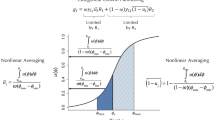Abstract
Competition in ecology is often modeled in terms of direct, negative effects of one individual on another. An example is logistic growth, modeling the effects of intraspecific competition, while the Lotka-Volterra equations for competition extend this to systems of multiple species, with varying strengths of intra- and interspecific competition. These equations are a classic and well-used staple of quantitative ecology, providing a framework to understand species interactions, species coexistence, and community assembly. They can be derived from an assumption of random mixing of organisms, and an outcome of each interaction that removes one or more individuals. However, this framing is somewhat unsatisfactory, and ecologists may prefer to think of phenomenological equations for competition as deriving from competition for a set of resources required for growth, which in turn may undergo their own complex dynamics. While it is intuitive that these frameworks are connected, and the connection is well-understood near to equilibria, here, we ask the question: when can consumer dynamics alone become an exact description of a full system of consumers and resources? We identify that consumer-resource systems with this property must have some kind of redundancy in the original description, or equivalently there is one or more conservation laws for quantities that do not change with time. Such systems are known in mathematics as integrable systems. We suggest that integrability in consumer-resource dynamics can only arise in cases where each species in an assemblage requires a distinct and unique combination of resources, and even in these cases, it is not clear that the resulting dynamics will lead to Lotka-Volterra competition.

Similar content being viewed by others
References
Abrams PA (2009) Determining the functional form of density dependence: deductive approaches for consumer-resource systems having a single resource. Am Nat 174(3):321–330
Abrams PA, Rueffler C, Dinnage R (2008) Competition-similarity relationships and the nonlinearity of competitive effects in consumer-resource systems. Am Nat 172(4):463–474
Arnol’d VI (2013) Mathematical methods of classical mechanics, vol 60. Springer Science & Business Media, New York
Chase J, Leibold M (2003) Ecological niches. University of Chicago Press, Chicago
Chesson P (1990) Macarthur’s consumer-resource model. Theor Popul Biol 37(1):26–38
Chesson P (2000) Mechanisms of maintenance of species diversity. Annu Rev Ecol Syst 31:343–366
De Baar HJW (1994) von Liebig’s law of the minimum and plankton ecology (1899–1991). Prog Oceanogr 33 (4):347–386
Droop MR (1973) Some thoughts on nutrient limitation in algae. J Phycol 9(3):264–272
Droop MR (1974) The nutrient status of algal cells in continuous culture. J Mar Biol Assoc U K 54(4):825–855
Embree M, Liu JK, Al-Bassam MM, Zengler K (2015) Networks of energetic and metabolic interactions define dynamics in microbial communities. Proc Natl Acad Sci 112(50):15450–15455
Fisher CK, Mehta P (2014) Identifying keystone species in the human gut microbiome from metagenomic timeseries using sparse linear regression. PloS One 9(7):e102451
Gause GF (1932) Experimental studies on the struggle for existence. J Exp Biol 9(4):389–402
Gause GF, Witt AA (1935) Behavior of mixed populations and the problem of natural selection. Am Nat 69(725):596–609
Ghoul M, Mitri S (2016) The ecology and evolution of microbial competition. Trends Microbiol 24 (10):833–845
Gleeson SK, Tilman D (1992) Plant allocation and the multiple limitation hypothesis. Am Nat 139 (6):1322–1343
Grilli J, Barabás G, Michalska-Smith MJ, Allesina S (2017) Higher-order interactions stabilize dynamics in competitive network models. Nature 548(7666):210
Harpole WS, Ngai JT, Cleland EE, Seabloom EW, Borer ET, Bracken MES, Elser JJ, Gruner DS, Hillebrand H, Shurin JB et al (2011) Nutrient co-limitation of primary producer communities. Ecol Lett 14(9):852–862
Knobloch E, Wiesenfeld KA (1983) Bifurcations in fluctuating systems: the center-manifold approach. J Stat Phys 33(3):611– 637
Lakin WD, Van Den Driessche P (1977) Time scales in population biology. SIAM J Appl Math 32(3):694–705
Letten AD, Ke P-J, Fukami T (2017) Linking modern coexistence theory and contemporary niche theory. Ecol Monogr 87(2):161–177
Levine JM, Bascompte J, Adler PB, Allesina S (2017) Beyond pairwise mechanisms of species coexistence in complex communities. Nature 546(7656):56
Levins R (1969) Some demographic and genetic consequences of environmental heterogeneity for biological control. Am Entomol 15(3):237–240
Lorenz EN (1992) The slow manifold what is it? J Atmos Sci 49(24):2449–2451
Lotka AJ (1926) Elements of physical biology. Sci Prog Twent Century (1919–1933) 21(82):341–343
MacArthur R (1970) Species packing and competitive equilibrium for many species. Theor Popul Biol 1(1):1–11
MacArthur R, Levins R (1967) The limiting similarity, convergence, and divergence of coexisting species. Am Nat 101:377–385
Marino S, Baxter NT, Huffnagle GB, Petrosino JF, Schloss PD (2013) Mathematical modeling of primary succession of murine intestinal microbiota.Proc Natl Acad Sci 111:439–444
Marsden JE, Ratiu T (2013) Introduction to mechanics and symmetry: a basic exposition of classical mechanical systems, vol 17. Springer Science & Business Media, New York
Mobilia M, Georgiev IT, Täuber UC (2007) Phase transitions and spatio-temporal fluctuations in stochastic lattice lotka–volterra models. J Stat Phys 128(1–2):447–483
Otto SP, Day T (2011) A biologist’s guide to mathematical modeling in ecology and evolution. Princeton University Press, Princeton
Plank M (1995) Hamiltonian structures for the n-dimensional lotka–volterra equations. J Math Phys 36 (7):3520–3534
Reynolds SA, Brassil CE (2013) When can a single-species, density-dependent model capture the dynamics of a consumer-resource system? J Theor Biol 339:70–83
Rosenzweig ML, MacArthur RH (1963) Graphical representation and stability conditions of predator-prey interactions. Am Nat 97(895):209–223
Saito MA, Goepfert TJ, Ritt JT (2008) Some thoughts on the concept of colimitation: three definitions and the importance of bioavailability. Limnol Oceanogr 53(1):276–290
Schaffer WM (1981) Ecological abstraction: the consequences of reduced dimensionality in ecological models. Ecol Monogr 51(4):383–401
Taillefumier T, Posfai A, Meir Y, Wingreen NS (2017) Microbial consortia at steady supply. eLife 6
Tilman D (1977) Resource competition between plankton algae: an experimental and theoretical approach. Ecology 58(2):338–348
Volterra V (1926) Fluctuations in the abundance of a species considered mathematically. Nature 118 (2972):558–560
Volterra V (1928) Variations and fluctuations of the number of individuals in animal species living together. J Cons Int Explor Mer 3(1):3–51
Volterra V (1931) Lectures on the mathematical theory of struggle for life. Gauthier-Villars, Paris
von Liebig JF (1855) Principles of agricultural chemistry: with special reference to the late researches made in E ngland. Walton & Maberly, London
Zomorrodi AR, Segrè D (2016) Synthetic ecology of microbes: mathematical models and applications. J Mol Biol 428(5):837–861
Acknowledgments
I thank Mario Muscarella, Nick Laracuente, and Alice Doucet Beaupré for constructive criticism on an earlier draft of this manuscript, and Rafael D’Andrea for productive conversations on the history of modeling colimitation. I thank two anonymous reviewers for extremely helpful comments and constructive criticism. I acknowledge Peter Abrams for sending comments and references relating to the separation of timescales approximation, and Sally Otto and Troy Day for commenting on the history of reducing the number of degrees of freedom in SIS and related models.
Funding
This works was supported by the Simons Foundation Grant #376199 and the McDonnell Foundation Grant #220020439.
Author information
Authors and Affiliations
Corresponding author
Appendices
Appendix A: The Hamiltonian formalism for consumer-resource dynamics
A.1 Competition for a single resource
The construction in the main text for logistic growth (Abiotic resource and separation of timescales) also forms part of a more general picture. Equation 11 is a Hamiltonian system (Arnol’d 2013; Marsden and Ratiu 2013), which can be seen by recasting in terms of a pair of canonical variables, say x(t) and y(t) and a Hamiltonian, H(x, y). For a Hamiltonian system, the defining equations must take the form:
To see this structure explicitly in our case, there is considerable freedom in choosing the variables x(t) and y(t). An example is
The Hamiltonian is then proportional to the conserved quantity we already saw:
and in terms of these new variables, we can rewrite the consumer-resource dynamics explicitly as Hamiltonian dynamics:
We could also change to another set of canonical variables where the dynamics look even simpler:
With the Hamiltonian defined as before, H(J, a) = J and hence is independent of the new canonical variable a. This leads to very simple equations of motion
The advantage of these variables is that the solution a = −t + const is straightforward to obtain, and this can of course be translated back into the familiar logistic model solution for N(t) if necessary.
While the existence of a conserved quantity is on its own sufficient to derive logistic growth for the consumer, making the Hamiltonian formulation slightly superfluous for that specific purpose, we speculate that the structure of Hamiltonian systems may lead to additional insights, beyond this case. This Hamiltonian picture is already known to generalize to a broad range of ecological dynamics (Plank 1995). In particular, any two-variable system of the form
has a conserved quantity and a Hamiltonian formulation provided that b11b2(b12 − b22) + b22b1(b21 − b11) = 0 (Plank 1995). Our example above (with a redefinition of R to R − d/β) clearly falls into this category, and another familiar example is the Lotka-Volterra predator-prey equations, for biotic (but unregulated) consumers and resources. This has b11 = b22 = 0, and the Hamiltonian
On the other hand, not every Hamiltonian will lead to a single-valued expression for N in terms of R. For example, if b21, b12 < 0, and b2, b1 > 0 in Eq. 28, we cannot rearrange the equation to extract a single-valued solution for R in terms of N and (the constant) Hpp. And so while the existence of a conserved quantity seems essential for finding an exact description of consumer-resource dynamics in terms of consumers alone, it is not necessarily straightforward (or even possible) to use this quantity to derive an ordinary differential equation for N alone.
A.2 Competition for substitutable resources
Like the single consumer-single resource system, Eq. 16 in the main text can also be recast as a Hamiltonian system, with the Hamiltonian:
To see the Hamiltonian property explicitly, consider (for example) the change of variables:
Then, with \(H(x_{1},y_{1},x_{2},y_{2}) = e^{x_{1}} + e^{x_{2}} +e^{\beta _{11}y_{1}+\beta _{21}y_{2}}+e^{\beta _{22}y_{2}+\beta _{12}y_{1}}\) defined as above,
So far, the analysis is very similar to the case of one consumer and one resource. On the other hand, there is no second conserved quantity here, and so it is only possible to eliminate one of the four dynamical variables, not two. Finally, we note that in the case of essential resources considered in “Essential abiotic resources and multiplicative colimitation”, we are unable to find a Hamiltonian formalism.
Appendix B: Multiplicative and Liebig colimitation
In the main text, we motivate a particular form of colimitation by multiple resources, where each resource must be gathered (in a prescribed quantity) at the same time in order for the consumer to add biomass. The resulting equations are essentially the same as chemical reaction equations for chemicals in a vat. We now present a sketch of how both the Liebig form (a single limiting reaction) and multiplicative colimitation can arise from limits of the same sequence of reactions. Consider a consumer, C, who reaches an intermediate state, D, after uptake of one unit of resource 1, but where this intermediate state can decay back to state C. This is then followed by uptake of resource 2 to make two consumers (i.e., to generate new biomass):
We can represent this system by the ODEs for consumer density N, intermediate consumer density M, and resource concentrations R1 and R2:
where I am supposing that the resource concentrations are fixed externally or slowly changing, the γ, δ are various reaction rates and μ is a decay rate of the intermediate state back to C. Next, suppose that we can assume a separation of timescales (precisely what I’ve argued against in general in the main text, but like those cases, there are limits in which this approximation is reasonable). Then, we can assume \(\frac {dM}{dt}= 0\) and set
Substituting into Eq. 33, we have that
If the decay reaction is rare or absent so that we can ignore μ, then this becomes
I.e., this limit is consistent with one of the two resources (Res1) being rate limiting, and the growth rate of the consumer only depends on this resource. On the other hand, we could also assume that μ is very large. In the limit of small \(\frac {\delta R_{2}}{\mu }\),
and so we recover the multiplicative form. This is simply saying that if decay via μ overwhelms the formation of the intermediate state, D, then in effect, the consumer still needs to gather both resources simultaneously. Finally, if we assume a separation of timescales but now assume that the first reaction is fast, then we can approximately set \(\frac {dN}{dt} = 0\) and obtain
Substituting this into the remaining equation, we have
Hence, both the intermediate state, D, and by Eq. 39 the consumer, C, grow exponentially with rate determined by δR2. I.e., the second resource is limiting, rather than the first. Therefore, with the caveats necessary to trust this “separation of timescales” approach, all three cases (both of Liebig’s possible laws of the minimum and multiplicative colimitation) can arise as limiting cases of this simple sequence of reactions. It is unclear whether either approximation dominates in colimitation in nature, though there seems to be stronger evidence for Liebig. Perhaps a more systematic approximation method for microbial metabolic networks may pay dividends in understanding which of these cases (if any) apply in a given natural system.
Rights and permissions
About this article
Cite this article
O’Dwyer, J.P. Whence Lotka-Volterra?. Theor Ecol 11, 441–452 (2018). https://doi.org/10.1007/s12080-018-0377-0
Received:
Accepted:
Published:
Issue Date:
DOI: https://doi.org/10.1007/s12080-018-0377-0




